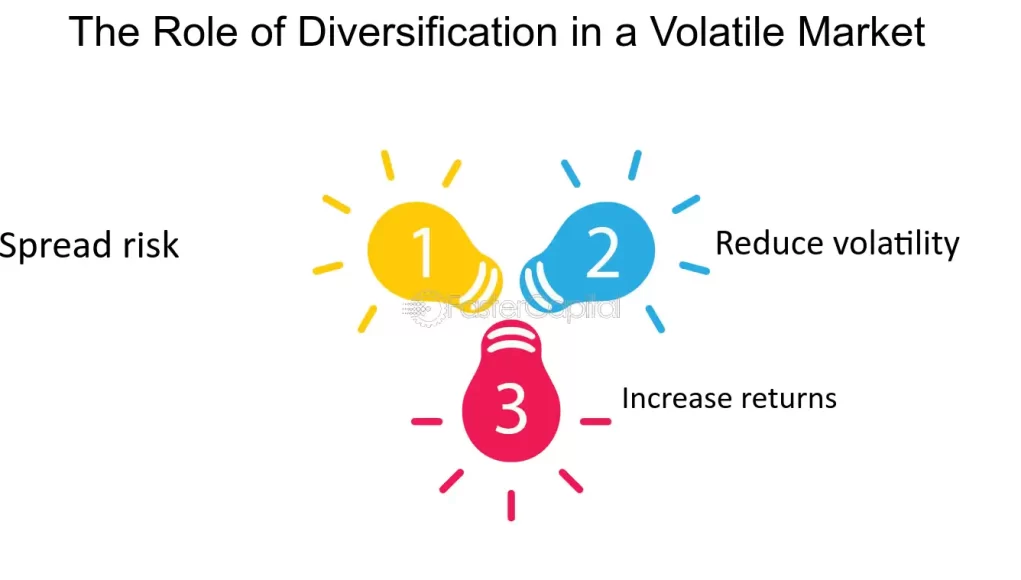Market volatility can be a challenging environment for investors. Sudden price swings, driven by economic events, geopolitical tensions, or unexpected market shocks, often lead to uncertainty and potential losses. In such conditions, diversification remains a cornerstone of successful investing.
This blog explores why diversification is essential in volatile markets, how it helps mitigate risks, and the best strategies to achieve a balanced and resilient portfolio.
What is Diversification?
Diversification is the practice of spreading investments across various asset classes, industries, and geographic regions to reduce risk. The goal is to ensure that if one investment performs poorly, others in your portfolio can offset the loss, maintaining overall stability.
For example, instead of putting all your money into tech stocks, a diversified portfolio might include tech stocks, bonds, real estate, and commodities like gold.
Why is Diversification Important in Volatile Markets?
Volatile markets are characterized by rapid and unpredictable price movements. These fluctuations can result from factors such as:
- Global Economic Uncertainty: Recession fears or inflation.
- Geopolitical Events: Wars, trade disputes, or political instability.
- Market-Specific Shocks: Industry disruptions, corporate scandals, or regulatory changes.
In such environments, diversification helps investors in several key ways:
1. Risk Mitigation
Diversification reduces the impact of a poor-performing asset. For instance, during a market downturn, bonds or defensive stocks like consumer staples often perform better than growth-oriented equities.
2. Steady Returns
By spreading investments across assets with varying risk profiles, investors can achieve a more consistent return. For example, while stocks offer high growth potential, bonds provide steady income, balancing out the portfolio.
3. Protection Against Sector-Specific Declines
Volatility often impacts specific industries disproportionately. A diversified portfolio minimizes the damage from a sector-specific downturn, such as the 2022 tech stock crash.
4. Capital Preservation
In volatile markets, preserving capital becomes a priority. Diversification ensures that investors do not put all their money in high-risk assets, safeguarding their investment from significant losses.
How to Diversify Your Portfolio in Volatile Markets
1. Diversify Across Asset Classes
Invest in a mix of:
- Equities: Stocks provide growth potential but come with higher risk.
- Bonds: Offer stability and regular income.
- Real Estate: Physical assets or REITs (Real Estate Investment Trusts) can hedge against inflation.
- Commodities: Gold, silver, and other commodities often perform well in uncertain times.
- Cash: Maintaining liquidity allows you to take advantage of new opportunities during market dips.
2. Geographic Diversification
Spread investments across different regions to mitigate the impact of localized economic issues. For example:
- Invest in U.S. stocks, emerging markets, and European equities.
- Consider international ETFs (Exchange-Traded Funds) or mutual funds.
3. Sectoral Diversification
Avoid concentrating investments in a single sector. Build a portfolio that includes sectors such as:
- Technology
- Healthcare
- Energy
- Consumer staples
- Utilities
4. Diversify Within Asset Classes
Even within a single asset class like equities, ensure diversification:
- Large-Cap, Mid-Cap, and Small-Cap Stocks: Balance growth and stability.
- Growth vs. Value Stocks: Growth stocks offer high potential returns, while value stocks provide stability.
5. Consider Alternative Investments
Alternative investments such as private equity, hedge funds, or cryptocurrencies can offer additional diversification. However, these should be approached with caution and limited exposure due to their higher risk.
6. Rebalance Regularly
Periodic rebalancing ensures your portfolio remains aligned with your investment goals and risk tolerance. For example, if equities outperform bonds significantly, you may need to reduce stock exposure and reinvest in bonds.
Real-World Example of Diversification in Action
During the COVID-19 market crash of 2020, diversified portfolios fared better than those heavily weighted in stocks. While equity markets dropped sharply, investments in bonds, gold, and healthcare stocks cushioned the blow, enabling diversified investors to recover more quickly.
Similarly, in the 2022 inflation-driven volatility, portfolios with exposure to commodities like oil and agricultural products outperformed stock-heavy portfolios.
The Role of Diversification in Long-Term Success
While diversification cannot eliminate all risks, it is a powerful tool to manage and reduce them, particularly in volatile markets. A well-diversified portfolio provides:
- Resilience during economic downturns.
- Opportunities for growth by capturing gains across multiple sectors.
- Peace of mind for investors by minimizing unexpected losses.
Common Diversification Mistakes to Avoid
1. Over-Diversification
Having too many investments can dilute returns and make portfolio management difficult. Aim for quality over quantity.
2. Ignoring Correlation
Ensure investments are not highly correlated. For example, owning multiple stocks in the same industry does not provide true diversification.
3. Failing to Rebalance
Markets change, and so do the weights of your investments. Rebalancing ensures your portfolio remains optimized for your goals.
4. Following Trends Blindly
Investing in trending sectors or assets without considering their risk can lead to significant losses during volatility.
Conclusion
Diversification is not just a buzzword—it is a critical strategy for navigating volatile markets. By spreading investments across asset classes, industries, and regions, you can reduce risk, preserve capital, and maintain steady returns even during turbulent times.
In 2025, market volatility is expected to remain a constant challenge for investors. A diversified portfolio, coupled with regular rebalancing and a focus on long-term goals, can help you weather the storm and emerge stronger.
Invest wisely, diversify effectively, and let your portfolio work for you, no matter the market conditions.
FAQs
Q1: Can diversification eliminate all risks?
No, diversification reduces risk but cannot eliminate it entirely. Systematic risks, such as economic recessions, impact all investments.
Q2: How often should I rebalance my portfolio?
Rebalance at least once a year or whenever your asset allocation deviates significantly from your target.
Q3: Is it possible to diversify with a small budget?
Yes, ETFs and mutual funds allow small investors to diversify across multiple assets cost-effectively.
Q4: What is the 60/40 portfolio rule?
The 60/40 rule recommends allocating 60% to equities and 40% to bonds, balancing growth and stability.
Q5: Should I diversify in cryptocurrencies?
If investing in crypto, diversify across established coins like Bitcoin and Ethereum and smaller altcoins, but keep your exposure minimal due to high risk.
Invest smart, stay diversified, and achieve your financial goals in any market condition!



































